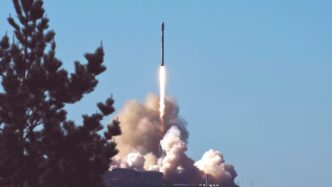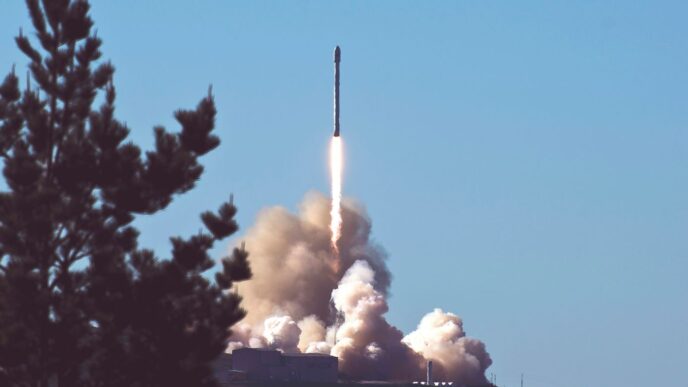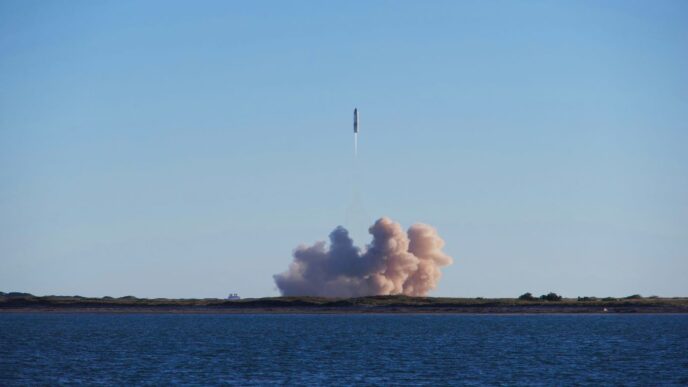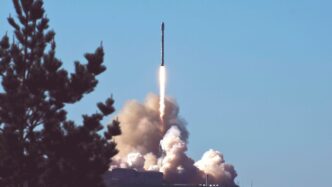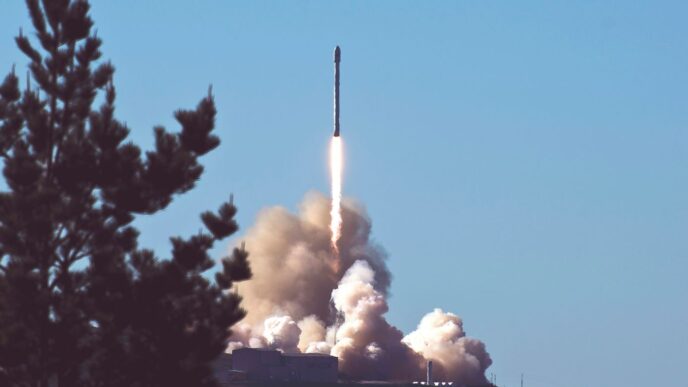Ever look up at the night sky and wonder what’s up there? Satellites whiz by, planets glow, and constellations tell ancient stories. For a long time, figuring out what you were seeing meant lugging around heavy books or knowing a lot of trivia. But now, there’s a much easier way. A good satellite tracker app can turn your phone into a personal guide to the cosmos, showing you everything from the International Space Station to distant galaxies. Let’s check out how these apps work and what they can do for you.
Key Takeaways
- A satellite tracker app helps you find and identify objects in the sky, like satellites, planets, and stars.
- Many apps use your phone’s camera and GPS to show you a real-time map of the sky.
- Some apps let you see what the sky looked like in the past or what it might look like in the future.
- You can track specific objects like the International Space Station (ISS) and see when it will pass over your location.
- Features like augmented reality (AR) and offline modes make these apps useful for everyone, from beginners to experienced sky watchers.
Understanding Your Satellite Tracker App
So, you’ve got this app, right? It’s like having a personal guide to the sky, but instead of pointing out landmarks, it’s showing you where all those man-made objects are whizzing around above us. It’s pretty neat, honestly. These apps aren’t just fancy pictures; they’ve got some real tools to help you out.
Core Features of a Satellite Tracker App
Most of these apps come with a few key things that make them useful. Think of them as the basic toolkit for any sky watcher.
- Real-time Location: This is the big one. The app shows you where satellites are right now. It’s not a static map; it updates as they move.
- Satellite Data: You can usually tap on a satellite and get some info. Things like its name, altitude, and how fast it’s going. It’s like a little ID card for each one.
- Pass Predictions: This is super handy. The app can tell you when a specific satellite, like the ISS, will be visible from your exact location. It’ll give you the time and how long it’ll be visible for.
Navigating the Cosmos with Real-Time Tracking
This is where the magic happens. The real-time tracking feature is what makes these apps feel alive. You point your phone up, and the app shows you what’s overhead. It’s not just about seeing dots; it’s about understanding their movement.
Imagine you’re looking at a satellite pass prediction. The app tells you a satellite will be visible in 10 minutes. With the real-time tracker, you can watch its little icon move across the map as it gets closer to your viewing window. It makes the whole experience more engaging, you know? You’re not just waiting; you’re actively following its journey.
Essential Tools for Satellite Alignment
Now, this part is more for folks who might be setting up their own satellite dishes, but it’s still a cool feature to know about. Some apps have tools that help you point your dish precisely.
- Azimuth and Elevation: The app will give you specific angles – azimuth (horizontal direction) and elevation (upward angle) – that you need to set your dish to. It’s like giving you the exact coordinates.
- Compass Integration: Many apps use your phone’s compass. As you move your phone, the compass on the screen moves too, showing you the direction you need to point. This makes aiming your dish much simpler than trying to guess.
- Signal Strength Indicators: While not always present, some advanced apps might even give you feedback on signal strength as you adjust, helping you fine-tune the alignment for the best possible reception.
Exploring Celestial Objects with Your App

So, you’ve got your satellite tracker app open, and you’re ready to see what’s out there. It’s not just about satellites, though. These apps are like having a portable planetarium in your pocket, ready to show you the whole universe. You can identify pretty much anything you see in the night sky, from the brightest planets to the faintest stars. It’s pretty amazing how much detail you can get.
Identifying Stars, Planets, and Constellations
Ever looked up and wondered, "What’s that bright star?" Your app can tell you. Just point your phone at the sky, and it’ll overlay names and information onto your screen. It’s like having a knowledgeable friend guiding you through the constellations. You can learn the stories behind them, like how Orion the Hunter got his belt or why Ursa Major is often called the Big Dipper. Most apps have a massive database, so you can look up over 600,000 stars. It’s a great way to connect with the sky.
- Point and Identify: Simply aim your device at a celestial object.
- Learn the Lore: Discover the mythology and history behind constellations.
- Track Planetary Movements: See where planets like Venus or Jupiter are in their orbits.
Discovering Deep-Sky Objects and Comets
Beyond the familiar stars and planets, there’s a whole universe of fainter, more distant objects. Think nebulae, galaxies, and star clusters. Many apps let you find these, even if they look like smudges or nothing at all to the naked eye. You can zoom in on images and read about their composition and distance. Some apps even track comets, letting you know when one might be visible. It’s a fantastic way to appreciate the sheer scale of the cosmos. You can even explore views of the universe in different light spectrums, like X-ray or infrared, which is pretty wild.
Visualizing Orbital Paths and Celestial Events
What makes these apps really cool is their ability to show you how things move. You can see the orbital paths of satellites, planets, and even the Moon. This helps you understand why certain objects appear where they do in the sky. Plus, many apps will notify you about upcoming celestial events. We’re talking meteor showers, eclipses, and planetary conjunctions. You can even use a time-travel feature to see what the sky looked like in the past or what it will look like in the future. It’s a great way to plan your stargazing sessions and not miss out on any cosmic action. You can even simulate past meteor showers or upcoming comets with some of these tools. For example, you can check out ISS passes to see when the International Space Station will be visible from your location.
Advanced Functionality for Space Enthusiasts
So, you’ve got the basics down – you can point your phone at the sky and know what you’re looking at. That’s pretty cool, right? But some apps go way beyond just identifying stars. They offer features that really let you dig into the science and wonder of space.
Utilizing Augmented Reality for Sky Mapping
This is where things get really futuristic. Many apps now use your phone’s camera to overlay information directly onto the sky you’re seeing. It’s like having a digital window into space. You can point your phone at a seemingly empty patch of sky, and suddenly, constellations, planets, and even satellites pop up with labels and details. It makes the vastness of space feel a lot more approachable. Some apps even let you see how the sky would look from different locations on Earth, which is neat if you’re planning a trip or just curious.
Leveraging the Time Travel Feature
Ever wondered what the night sky looked like a hundred years ago, or what it will look like next month? A few apps have a ‘time travel’ function that lets you do just that. You can scroll forward or backward through dates and see how celestial bodies move. It’s a fantastic way to understand orbital mechanics without needing a physics textbook. You can watch a planet rise and set at a specific time in the past or future, or see how a meteor shower played out on a particular night. It really helps put the slow, grand dance of the cosmos into perspective. For example, you can check out the position of the International Space Station on any given date using this application.
Accessing Detailed Astronomical Information
Beyond just names and locations, the best apps provide a treasure trove of data. Think of it like a portable astronomy encyclopedia. You can tap on any object – a star, a planet, a nebula – and get a wealth of information. This often includes:
- Physical characteristics: Size, mass, temperature, composition.
- Historical context: When it was discovered, who discovered it, any interesting historical or mythological connections.
- Orbital data: How fast it’s moving, its path, its distance from Earth.
- Visibility charts: When and where to best see it from your location.
Some apps even include live data feeds from telescopes or space missions, giving you real-time insights into astronomical research. It’s a great way to learn more about the universe and the ongoing exploration of space.
Choosing the Right Satellite Tracker App
So, you’ve decided to get into tracking satellites, which is pretty cool. But with so many apps out there, how do you pick the one that’s actually going to be useful and not just a waste of your phone’s storage? It can feel a bit overwhelming, honestly. You want something that works well, doesn’t crash every five minutes, and actually helps you see what’s going on up there.
User-Friendly Interfaces for All Levels
First off, let’s talk about how easy the app is to use. If you’re just starting out, you don’t want to be staring at a screen full of confusing buttons and menus. A good app should feel pretty intuitive. You point your phone at the sky, and it tells you what you’re looking at, simple as that. Some apps have a "lite" version or a free trial, which is a great way to test the waters before committing. Look for apps that offer clear visuals and straightforward controls. It’s like learning to ride a bike; you want training wheels at first, right?
Offline Capabilities for Remote Exploration
This is a big one if you plan on doing any stargazing away from the city lights. You know, camping trips or just heading out to a darker spot. Not all apps work without an internet connection, but many of the better ones do. Having an offline mode means you can still identify satellites, planets, or constellations even if you’re miles from the nearest Wi-Fi signal. It’s pretty handy for those spontaneous trips where you forget to download maps or data beforehand.
Free vs. Premium Features in Satellite Apps
Okay, let’s get down to brass tacks: cost. Most apps will have a free version, but it might be missing some of the cooler features. You might get basic tracking, but maybe not the detailed orbital path visualizations or the time-travel function. Premium versions often add things like:
- Augmented Reality (AR) Overlays: See satellites overlaid directly onto your camera view.
- Advanced Object Databases: Access to more obscure satellites or deep-sky objects.
- Ad-Free Experience: No annoying pop-ups interrupting your cosmic view.
- Time Travel Feature: See where objects were in the past or will be in the future.
Think about what you really need. If you just want to know when the International Space Station is passing overhead, a free app might be perfectly fine. But if you’re really into the details, like tracking specific scientific satellites or exploring nebulae, you might find the premium features worth the price. It’s a trade-off between budget and functionality, really.
Beyond Satellites: A Universe of Discovery
While tracking satellites is pretty cool, your app can actually show you a whole lot more than just man-made objects whizzing around. It’s like having a personal observatory in your pocket, ready to show you the wonders of the universe.
Tracking the International Space Station
Sure, it’s a satellite, but the ISS is special. It’s a giant, human-inhabited laboratory orbiting Earth. Your app can pinpoint its exact location in real-time, showing you when it will be visible from your backyard. Seeing the ISS glide across the night sky is a truly awe-inspiring experience. Many apps will even give you details about its speed and altitude, making it feel like you’re part of the mission.
Exploring NASA Missions and Data
Some apps go a step further, connecting you to the incredible work being done by space agencies like NASA. You might find sections dedicated to current and past missions, complete with stunning images and fascinating facts. Imagine looking up at Jupiter and then being able to pull up details about the Juno probe that’s currently studying it. It’s a great way to learn about the science behind space exploration and see what we’re discovering out there.
Engaging with Astronomy Quizzes and News
Want to test your newfound knowledge or stay up-to-date with the latest cosmic happenings? Many satellite tracker apps include built-in quizzes to challenge your understanding of stars, planets, and constellations. You’ll also find sections with astronomy news, keeping you informed about significant celestial events, new discoveries, and upcoming astronomical phenomena. It’s a fun way to keep learning and get excited about what’s happening in space.
Keep Looking Up!
So there you have it. Whether you’re just curious about what’s whizzing overhead or you’re trying to point a dish just right, there’s an app out there for you. These tools make the vastness of space feel a little more reachable, turning your phone into a personal window to the cosmos. Don’t just take my word for it, though. Go ahead and download one, step outside on a clear night, and see for yourself. You might be surprised what you find.
Frequently Asked Questions
What exactly is a satellite tracker app?
Think of a satellite tracker app as your personal guide to the sky! It uses your phone’s location and sensors to show you where satellites are, both right now and when they’ll fly overhead. It’s like a map for space stuff, helping you spot things like the International Space Station or even weather satellites.
Can these apps help me find my TV satellite dish?
Yes, many satellite tracker apps have a special feature to help with that! They often include a compass and show you the exact direction and angle you need to point your satellite dish to get the best signal. It makes setting up your dish much easier.
Do I need internet to use a satellite tracker app?
Not always! Some apps have an offline mode. This means you can still use them to see where satellites are or find your dish even if you don’t have an internet connection, which is super handy if you’re out in the middle of nowhere.
Can I see more than just satellites with these apps?
Absolutely! Most of these apps are also amazing for stargazing. They can show you stars, planets, and constellations. Some even let you explore deep-sky objects like nebulae and galaxies, and they often have cool pictures and facts about them.
What is the ‘Time Travel’ feature in some apps?
The ‘Time Travel’ feature is like a magic window! It lets you see what the sky looked like on a past date or what it will look like in the future. So, you can check out what constellations were visible on your birthday last year or see when a comet might appear next month.
Are there free satellite tracker apps, or do I have to pay?
There are definitely free options! Many apps offer a basic version for free, which is great for getting started. Sometimes, the paid versions just add extra features like no ads, more detailed information, or advanced tools. You can usually try out the free version first to see if you like it.



